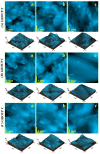Human Enamel Fluorination Enhancement by Photodynamic Laser Treatment
- PMID: 35890745
- PMCID: PMC9325182
- DOI: 10.3390/polym14142969
Human Enamel Fluorination Enhancement by Photodynamic Laser Treatment
Abstract
Poor oral hygiene leads to serious damages of theteeth's surface enamel such as micro-abrasions and acid erosion. These alterations combined with bacterial plaque result in cavity appearance. Prophylactic measures include various techniques for enamel surface restoration. Fluorination is one of the most important treatments for this purpose. Therefore, in the present research, we investigated the classical fluorination treatment compared with laser photodynamic fluorination performed on human enamel samples with poor surface quality. Three sample groups were investigated: veneer (F), inlay (I), and crowns (C). The general morphologic aspect was investigated by scanning electron microscopy (SEM), and the specific details such as the fine microstructure and nanostructure were investigated by atomic force microscopy (AFM) of the surface roughness. The samples were also investigated by Fourier transformed infrared attenuated total reflectance (FTIR-ATR) to evidence the fluorination effect on the enamel surface. Results showed that all initial samples had an altered state with micro-abrasions and erosion with mineral loss, which increase the surface roughness. The F group was the most damaged, having a higher roughness, and the I group was less damaged. Classic fluorination treatment partially restored the enamel by local re-mineralization, but did not obtain the parameters of healthy enamel. However, a significant decrease of the roughness was observed (statistical relevance p = 0.001 with the Breusch-Pagan Test). This fact was supported by the presence of newly formed fluorides in the FTIR-ATR spectra. The photodynamic laser fluorination restores the enamel in an enhanced manner by a strong re-mineralization, which implies a significant roughness value decrease comparable to healthy enamel. The Breusch-Pagan Test confirmed the relevance with p = 0.001. This is due to an extended re-mineralization abundant in fluoride crystals as observed by AFM and FTIR. Statistical p-values regarding laser application were in the range of 0.02-0.06, supporting its relevance in the fluorination effect. The final conclusion is that the photodynamic effect is able to favor the newly formed fluoride deposition onto the affected sites of the enamel surface.
Keywords: enamel fluorination; photodynamic laser treatment; re-mineralization; roughness.
Conflict of interest statement
The authors declare no conflict of interest.
Figures






References
-
- Qeli E., Toti C., Odorici A., Blasi E., Tragaj E., Tepedino M., Masedu F., Kacani G., Hysi D., Meto A., et al. Effectiveness of two different fluoride-based agents in the treatment of dentin hypersensitivity: A prospective clinical trial. Materials. 2022;15:1266. doi: 10.3390/ma15031266. - DOI - PMC - PubMed
-
- Meto A., Meto A., Targaj E., Lipo M., Bauermann C. The use of tiefenfluorid for desensitization of dentinal hyperesthesia. Balk J. Dent. Med. 2014;18:85–88.
-
- Kozaczuk S. Deep penetration fluoridation for caries prevention and treatment: The use of Tiefenfluorid junior in children. Case reports. Nowa Stomatol. 2020;1:15–25. doi: 10.25121/NS.2020.25.1.15. - DOI
LinkOut - more resources
Full Text Sources
Miscellaneous

